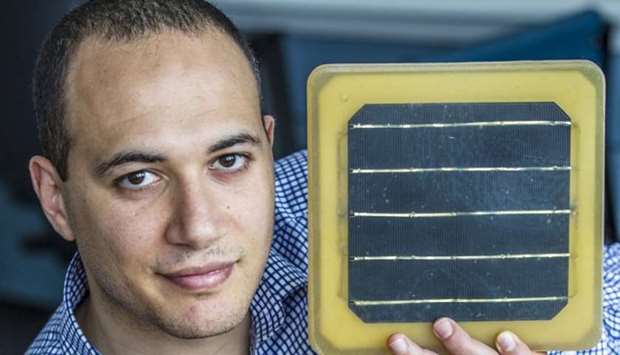*Renewable technology helps paved areas outside offices and homes to generate solar power
Researchers at a Qatar-funded project in the UK have invented a tile which can deliver renewable energy while also being tough enough to withstand pedestrian traffic, and waterproof to deal with the rainy weather.
The researchers are developing a way for the paved areas outside offices and homes to generate solar power which will light up the buildings we live and work in.
An international team including scientists at Glasgow Caledonian University has invented the tile, which comes at regular paving stone sizes, is made of a tough epoxy resin and contains photovoltaic cells which convert the energy from the sun into a flow of electrons.
Lead researcher Dr Azmy Gowaid and his team received $100,000 funding when organisers of the 2022 World Cup in Qatar invited competitive bids for innovative designs that could deliver a tournament powered by as much renewable energy as possible.
The team of five scientists has already conducted a pilot study at the Al Shamal stadium in Qatar and is planning to demonstrate its prototype either outside one of the World Cup venues or in a fan zone.
Dr Gowaid said: "Qatar has a drive to deliver as much as possible a sustainable tournament and so they are keen to get some sort of renewable technology running alongside the tournament."
Prior to that the PVTopia project will be rolled out in the hotter climates of North Africa and the Middle East where the tile’s innovative cooling system preventing heat damage will be put to the test under severe surface temperatures reaching 80 degrees Celsius.
"We want to see the tiles contribute to the energy supply mix of stadia, other sporting facilities and beyond to public squares, pavements, schools and university campuses," Dr Gowaid said.
Fatma al-Numai, of the Qatar tournament’s Supreme Committee for Delivery and Legacy, said: ‘We set up a legacy programme for exactly this reason – to support entrepreneurs, innovators and scientists like Dr Gowaid.
"What the team at PVTopia are doing is incredible and we can’t wait to see everything in action at the World Cup."
Dr Gowaid, who is a lecturer in Power Electronics at Glasgow Caledonian University, said:
"This is about enabling cities eventually to meet a part of their own energy needs rather than a technology that supplies the whole country’s needs.
"You’re looking - for a start - at the owners of residential houses or small commercial shops generating much of their energy needs on their own.
"If this is deployed amongst thousands and thousands of people then eventually the overall impact is going to relieve the (national) grid significantly.
"The spread of solar energy means roof space will be a diminishing resource. Meanwhile cities are getting more dense as electricity demand rises amid serious climate change challenges."
Dr Gowaid points out that while the costs of the tiles can be double that of normal paving, the energy they produce means the installation costs will soon be met.
Once the break-even point is reached the tiles will continue producing power for another 15-20 years – for free. Locked together in their hundreds they can create whole pavements which on sunny days will produce 200 watts of energy per square metre, and about 150 watts if cloudy.
Dr Gowaid said: “At low scale, say on a pavement of a street or general pedestrian walkways, the installation cost would be more than double the cost of paving stones. However, the generated revenue by feeding to street lighting, traffic systems, or simply selling energy to the electricity provider means the walkable solar pavement will be much cheaper than paving stones over the expected lifetime."
Traditional solar panels are mostly limited to slanting roofs as they cannot be walked on and render any space they lie on useless for other purposes.
To generate energy from flat rooftops that are normally used for other purposes, walkable solar tiles are a potential alternative solution.
As well as being made of a tough epoxy resin the tiles are also fitted in a hard frame from recyclable material that makes it very durable.
‘Should this prove successful, it is our dream that this product can eventually be installed at mass scale anywhere in the world ," said Dr Gowaid.

